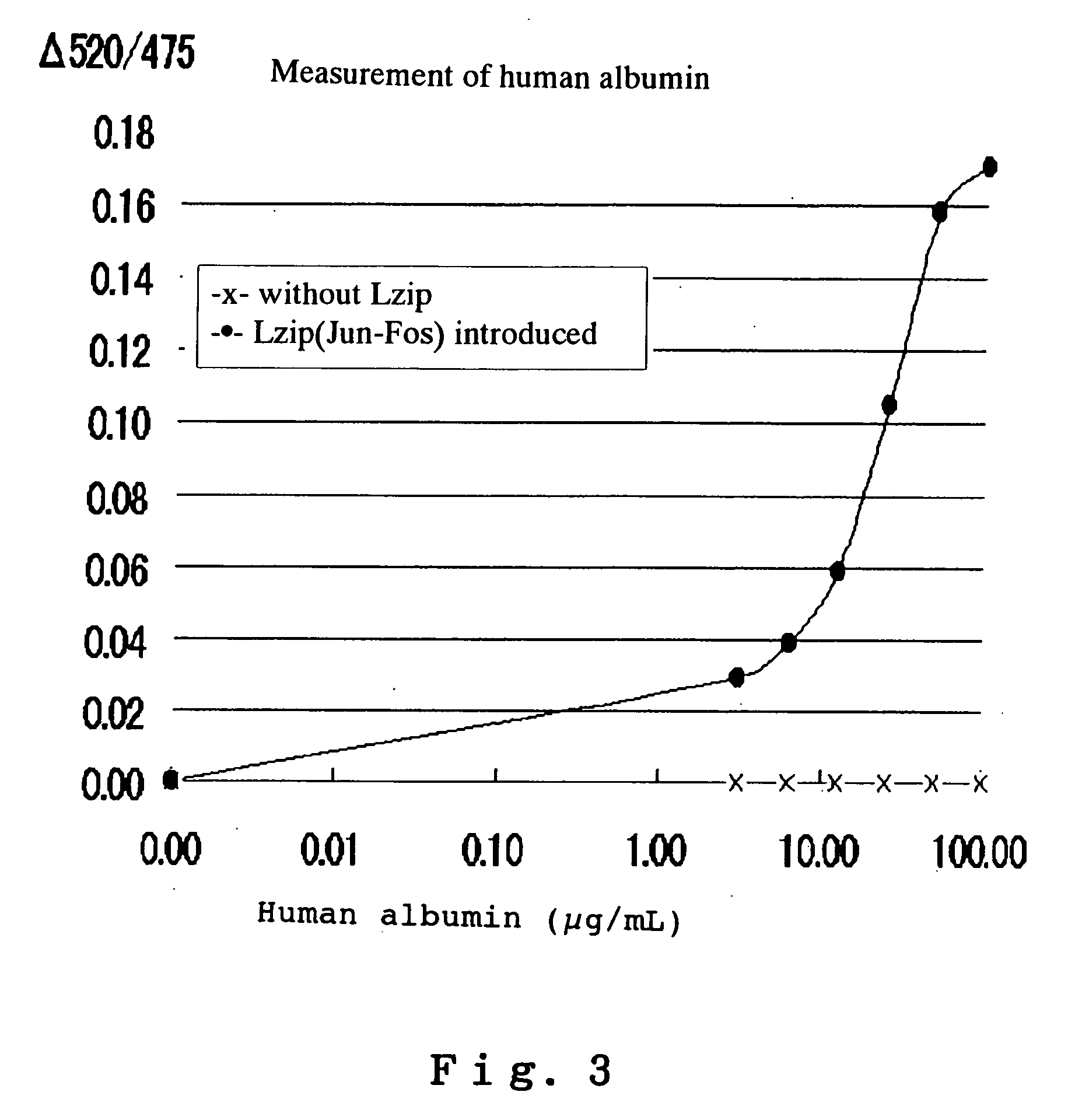Analysis method using reporter (label) intermolecular interaction
an analysis method and reporter technology, applied in the direction of positive displacement liquid engines, laboratory glassware, instruments, etc., can solve the problems of low sensitivity of measurement, complex and time-consuming washing operation for removing unreacted labeled antibodies, and cannot apply the principle to all antibodies
- Summary
- Abstract
- Description
- Claims
- Application Information
AI Technical Summary
Benefits of technology
Problems solved by technology
Method used
Image
Examples
example 1
Isolation of Fluorescent Protein EYFP and ECFP DNA
[0068] For EYFP, EGFP DNA was amplified by means of PCR using Pfu DNA polymerase (Stratagene) with pEGFP (Clontech) as a template. The primers
[0069] 5'-CCGCGGCCGCCATGGTGAGCAAGGGCGAGGAGCTG-3' (SEQ ID No. 1) and
[0070] 5'-CCCTCGAGCTTGTACAGCTCGTCCATGCCGAG-3' (SEQ ID No. 2) were used. The product of PCR was digested with the restriction enzymes NotI and XhoI, then separated and purified by 1% agarose gel electrophoresis, and inserted into the NotI and XhoI sites of pBluescript II KS+ (Stratagene) (pBS / EGFP). Based on this pBS / EGFP and using the following two primers
[0071] 5'-CCCTCGTGACCACCTTCGGCTACGGCCTGCAGTGCTTCGCCCGCTACCCCGACC-3' (SEQ ID No. 3) and
[0072] 5'-CCACTACCTGAGCTACCAGTCCGCCCTGAG-3' (SEQ ID No. 4) site-directed mutagenesis was carried out by means of the Kunkel method (the 4 residues substituted were S65G, V68L, S72A, and T203Y) to give EYFP.
[0073] For ECFP, ECFP DNA was amplified by means of PCR using Pfu DNA polymerase with pE...
example 2
Preparation of Flexible Linker DNA
[0077] Using the two primers below and Pfu DNA polymerase, by carrying out an annealing / growth reaction a flexible linker (called `FL4` below) DNA fragment was prepared.
[0078] The primers
[0079] 5'-CCCAAGCTTTCCGGCGGGGGTGGCTCCGGCGGGGGTGGATCCGGTGGCGGTGGCTC-3' (SEQ ID No. 7) and
[0080] 5'-CCCCGCGGCCGCGCTACCGCCACCGCCGGAGCCACCGCCACCGGAT-3' (SEQ ID No. 8) were used.
[0081] The amino acid sequence of the flexible linker so prepared was
[0082] GGGGSGGGGSGGGGSGGGGS (SEQ ID No. 9)
[0083] The flexible linker DNA fragment so prepared was digested with the restriction enzymes HindIII and NotI, and subjected to 2% agarose gel electrophoresis, thereby cutting out and purifying the fragment.
example 3
Cloning of Leucine Zipper Sequence from c-Jun and FosB Gene Products
[0084] E. coli HB101 containing the c-Jun and FosB gene products pJac-1 and pBSKS-FosB (Riken DNA Bank) was cultured overnight at 37.degree. C. in 5 mL of LB broth (50 .mu.g / mL ampicillin), and the plasmid DNA was purified by the alkaline-SDS method. Leucine zipper (called `Lzip` below) DNA of each of the c-Jun and FosB was amplified by means of PCR using Pfu DNA polymerase with the purified plasmid DNA as a template. As primers, those below were used.
[0085] For c-Jun amplification
[0086] 5'-CCCCGGATCCGTCGACGAATTCAGTGGTTCATGACTTTCTGCTTAAGCTGTG-3' (SEQ ID No. 10),
[0087] 5'-CCCCCCTCGAGGGTGGCCGGATCGCTCGGCTAGAGG-3' (sequence No. 11);
[0088] For FosB amplification
[0089] 5'-CCCCGGATCCGTCGACGAATTCAGTGGGCCACCAGGACAAACTC-3' (SEQ ID No. 12)
[0090] 5'-CCCCCCTCGAGGGTGGCCTGACAGATCGACTTCAGGCGG-3' (SEQ ID No. 13)
[0091] The PCR reaction liquid was purified by phenol-chloroform extraction and ethanol precipitation, and restriction enzy...
PUM
| Property | Measurement | Unit |
|---|---|---|
| Concentration | aaaaa | aaaaa |
| Molecular weight | aaaaa | aaaaa |
| Energy | aaaaa | aaaaa |
Abstract
Description
Claims
Application Information
 Login to View More
Login to View More - R&D
- Intellectual Property
- Life Sciences
- Materials
- Tech Scout
- Unparalleled Data Quality
- Higher Quality Content
- 60% Fewer Hallucinations
Browse by: Latest US Patents, China's latest patents, Technical Efficacy Thesaurus, Application Domain, Technology Topic, Popular Technical Reports.
© 2025 PatSnap. All rights reserved.Legal|Privacy policy|Modern Slavery Act Transparency Statement|Sitemap|About US| Contact US: help@patsnap.com



